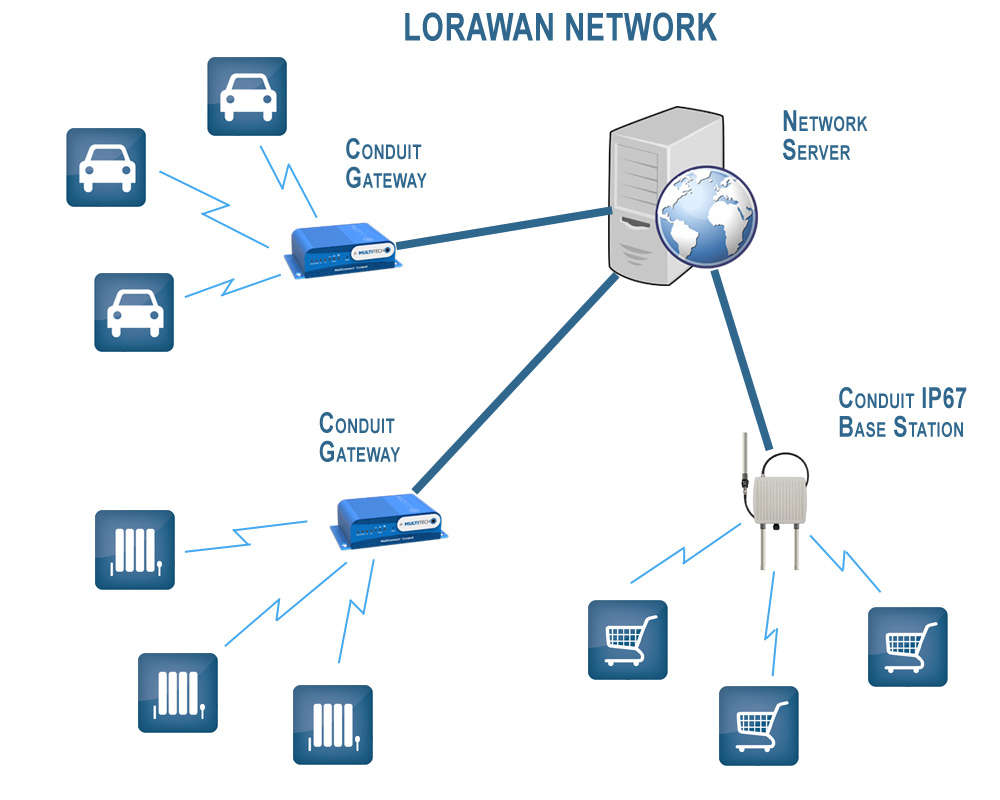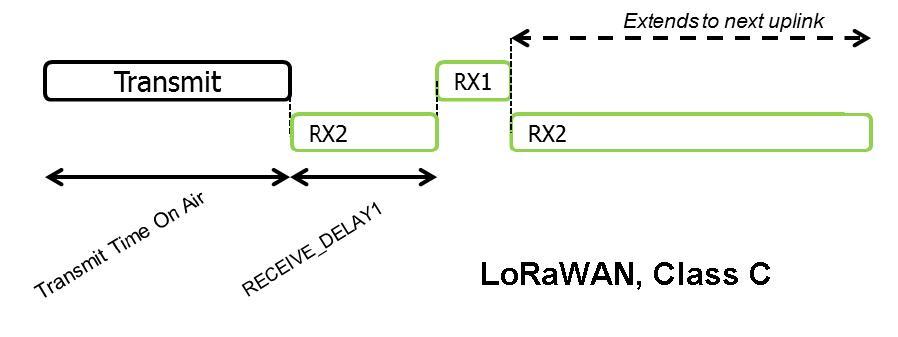LoRaWAN Specification. Introduction Basic concepts and classes of terminals
This article is an introduction to LoRaWAN wireless networks, and is based on the LoRaWAN 1.0.2 specification.

A typical LoRaWAN wireless network is a collection of gateways that forward messages between end-devices and a central server (Network Server, NS) and is characterized by a star-of-stars topology.

Gateways are also called concentrators and base stations . Terminal devices are often called motes .
Communication between gateways and the central server is through standard IP connections, and between gateways and end devices through wireless connections using LoRa broadband modulationor FSK. Modulation LoRa was developed by Semtech and is designed for low-speed wireless data transmission over distances of several kilometers in unlicensed frequency ranges (Europe - 433 and 868 MHz).
The communication between the gateways and the terminal devices is two-way, but it is assumed that the bulk of the data is transmitted from the terminal devices to the gateways. LoRa technology provides wireless transfer rates from 0.3 to 50 kbps . For the separation of channels, both a set of frequency channels and data rates are used.
To optimize the system, an adaptive data rate change is used - ADR (adaptive data rate). The network server evaluates the quality of the signal received from the terminal device, and can control both the transmission rate and the transmitter power of this device.
The terminal device can transmit data on any available channel and any transmission rate, given the following:
The main advantages of LoRaWAN wireless networks are due to the use of LoRa broadband modulation and unlicensed frequency ranges. LoRaWAN Networks:
A few words about possible applications:
Let's go back to the LoRaWAN specification and see what kind of devices are. At the end of 2016, the specification defines 3 classes of LoRaWAN terminals: A, B and C, which differ in receiving modes. Devices of these classes are bidirectional. Class A is basic and must be supported by all devices.
Class A devices after each transmission open two short time windows for reception (designated as RX1 and RX2).

The intervals from the end of the transmission to the opening of the first and second time windows can be configured, but must be the same for all devices in a given network (RECEIVE_DELAY1, RECEIVE_DELAY2). For the European 868 MHz band, the recommended RECEIVE_DELAY1 is 1 second. The value of RECEIVE_DELAY2 should be (RECEIVE_DELAY1 + 1) seconds.
The frequency channels and bit rates used for the RX1 and RX2 intervals may vary. Recommended values are given in a separate document - “LoRaWAN Regional Parameters”, available on the LoRa Alliance website .
Class A devices are the most low-consuming, but to transfer a message from the server to the terminal device, you must wait for the next outgoing message from this device.
In addition to the receive windows defined for Class A devices, Class B devices open additional scheduled receive windows. To synchronize the opening time of additional reception windows, gateways emit beacons. All gateways that are part of the same network must emit beacons at the same time. The beacon contains a network identifier and a time stamp (UTC).
The use of class B ensures that when interrogating terminals, the response delay will not exceed a certain amount determined by the period of the beacons.
Class C devices are in receive mode almost all the time except when they transmit messages. With the exception of the RX1 time window, the terminal uses the RX2 receive parameters.

Class C can be applied where it is not necessary to save energy (electric energy meters) or where it is necessary to interrogate terminal devices at arbitrary points in time.
So, with the basics of LoRaWAN and device classes a little figured out - in the next article we will discuss how to activate end devices.
Links on LPWAN:

Introduction to LoRaWAN
A typical LoRaWAN wireless network is a collection of gateways that forward messages between end-devices and a central server (Network Server, NS) and is characterized by a star-of-stars topology.

Gateways are also called concentrators and base stations . Terminal devices are often called motes .
Communication between gateways and the central server is through standard IP connections, and between gateways and end devices through wireless connections using LoRa broadband modulationor FSK. Modulation LoRa was developed by Semtech and is designed for low-speed wireless data transmission over distances of several kilometers in unlicensed frequency ranges (Europe - 433 and 868 MHz).
The communication between the gateways and the terminal devices is two-way, but it is assumed that the bulk of the data is transmitted from the terminal devices to the gateways. LoRa technology provides wireless transfer rates from 0.3 to 50 kbps . For the separation of channels, both a set of frequency channels and data rates are used.
To optimize the system, an adaptive data rate change is used - ADR (adaptive data rate). The network server evaluates the quality of the signal received from the terminal device, and can control both the transmission rate and the transmitter power of this device.
The terminal device can transmit data on any available channel and any transmission rate, given the following:
- Each time a message is transmitted, the frequency channel is randomly selected by the terminal device from the list of available channels.
- Before transmitting, the terminal must ensure that the channel is clear (Listen Before Talk, LBT). A feed is considered free if the measured instantaneous RSSI value is less than RSSI_FREE_TH. If the channel is busy, the device switches to another channel and repeats the LBT procedure.
- The terminal device must take into account local regulatory restrictions regarding the percentage of time that the device can occupy a frequency channel.
Key Benefits of LoRaWAN Networks
The main advantages of LoRaWAN wireless networks are due to the use of LoRa broadband modulation and unlicensed frequency ranges. LoRaWAN Networks:
- compatible with existing networks / technologies of wireless data transmission;
- have high noise immunity;
- capable of serving tens and hundreds of thousands of devices;
- provide a large coverage area and low power consumption of terminal devices.
LoRaWAN Wireless Applications
A few words about possible applications:
- reading gas, water, electricity meters;
- Smart Grid (monitoring of new generation electric networks;
- monitoring of vehicles and goods in a certain territory (location, information on the condition of vehicles and goods);
- control of the condition of containers / tanks at the production site (petrochemical production, containers for production waste, containers with hazardous substances);
- monitoring of production equipment (reducing downtime, monitoring parameters, ensuring personnel safety);
- smart parking (monitoring the availability of parking spaces);
- monitoring of garbage cans (optimization of garbage disposal processes);
- smart street lighting, etc. (remote control, status monitoring);
- weather monitoring;
- monitoring the status of hatches (preventing unauthorized entry);
- control of the presence of harmful substances in the atmosphere;
- collection of data on the state of the environment (pollution, noise, rain, wind, etc.);
- fire, security alarm;
- building automation (temperature, humidity control, gate control, blinds).
LoRaWAN terminal classes
Let's go back to the LoRaWAN specification and see what kind of devices are. At the end of 2016, the specification defines 3 classes of LoRaWAN terminals: A, B and C, which differ in receiving modes. Devices of these classes are bidirectional. Class A is basic and must be supported by all devices.
Class A (mandatory for all)
Class A devices after each transmission open two short time windows for reception (designated as RX1 and RX2).

The intervals from the end of the transmission to the opening of the first and second time windows can be configured, but must be the same for all devices in a given network (RECEIVE_DELAY1, RECEIVE_DELAY2). For the European 868 MHz band, the recommended RECEIVE_DELAY1 is 1 second. The value of RECEIVE_DELAY2 should be (RECEIVE_DELAY1 + 1) seconds.
The frequency channels and bit rates used for the RX1 and RX2 intervals may vary. Recommended values are given in a separate document - “LoRaWAN Regional Parameters”, available on the LoRa Alliance website .
Class A devices are the most low-consuming, but to transfer a message from the server to the terminal device, you must wait for the next outgoing message from this device.
Class B (Beacon)
In addition to the receive windows defined for Class A devices, Class B devices open additional scheduled receive windows. To synchronize the opening time of additional reception windows, gateways emit beacons. All gateways that are part of the same network must emit beacons at the same time. The beacon contains a network identifier and a time stamp (UTC).
The use of class B ensures that when interrogating terminals, the response delay will not exceed a certain amount determined by the period of the beacons.
Class C (Continuous)
Class C devices are in receive mode almost all the time except when they transmit messages. With the exception of the RX1 time window, the terminal uses the RX2 receive parameters.

Class C can be applied where it is not necessary to save energy (electric energy meters) or where it is necessary to interrogate terminal devices at arbitrary points in time.
So, with the basics of LoRaWAN and device classes a little figured out - in the next article we will discuss how to activate end devices.
Links on LPWAN:
- LoRaWAN Specification. Terminal Activation
- Multi-Tech Base Stations Deploy LoRaWAN in a Few Clicks
- We configure the LoRaWAN gateway and create our first IoT application
- NB-IoT, Narrow Band Internet of Things. General information and technology features.
- NB-IoT, Narrow Band Internet of Things. Power saving modes and control commands.
